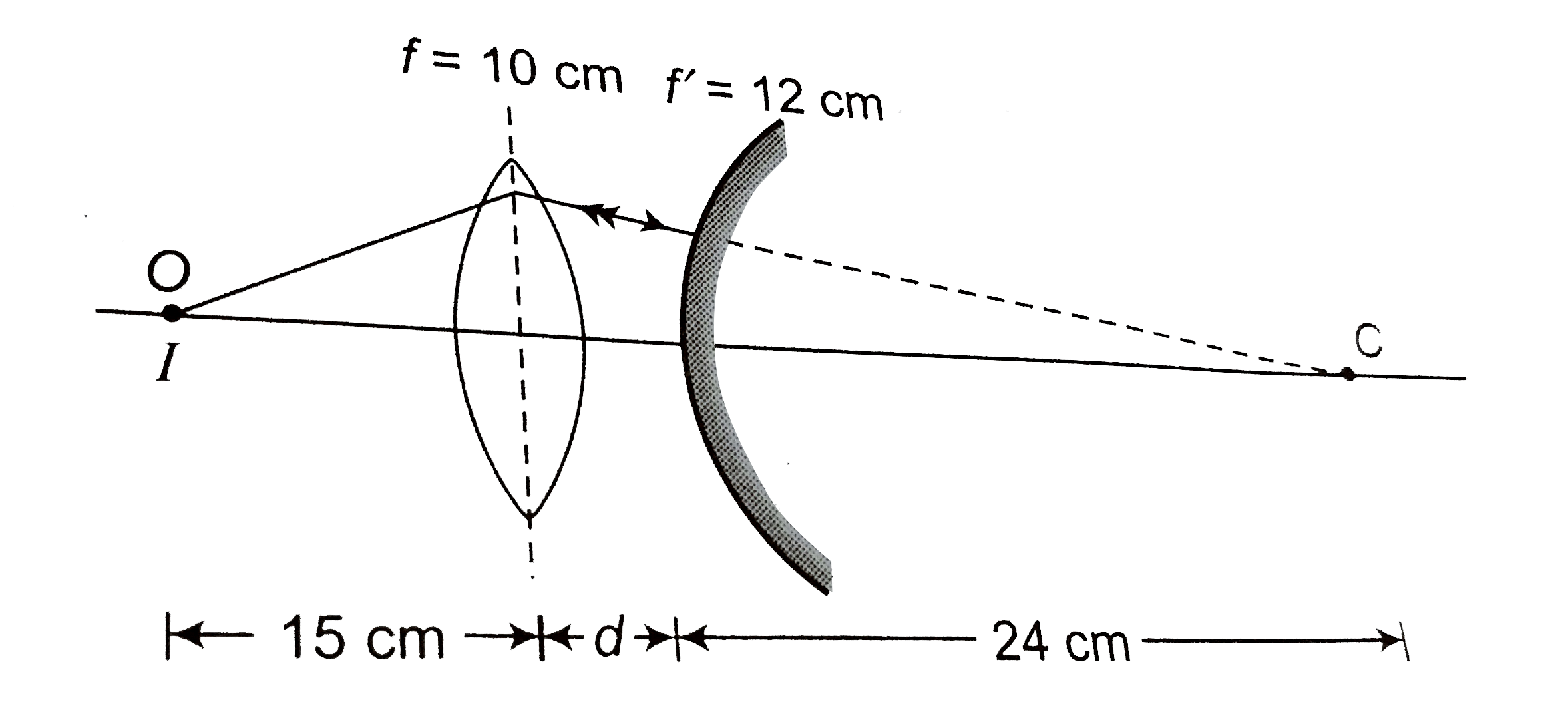(a) A point source S is placed at a distance of 15 cm from a converging lens of focal length 10 cm on its principal axis, where should a diverging mirror of focal length 12 cm be placed so that a real image is formed on the source itself?
(b) A diverging lens of focal length 20 cm and a converging mirror of focal length 10 cm are placed coaxially at separation of 5 cm. Where should an object be placed so that a real image is formed at the object itself?
(c) A converging lens of focal length 12 cm and a diverging mirror of focal length 7.5 cm are placed 5.0 cm apart with the principal axis coinciding where should an object be placed so that its image falls on itself?



(a) If final image and object are at same place by (lens+ mirror) combination for this rays after refraction must be incident normally on the mirror i.e., rays must be passed through centre of curvature of mirror. In brief, image by lens shoudl be formed on centre of curvature of mirror.
Image by lens should be at centre of curvature of mirror.
u=−15cm,f=10cm,v=(d+24)cm
1v−1u=1f⇒1v=1u+1f=1−15+110=130
v=30=d+24⇒d=6cm
(b) Image by lens should be formed at centre of curvature of mirror which is 15 cm left to lens.
u=−x,v=−15,f=−20cm
1v−1u=1f
1−15−1−x=1−20⇒1x=115−120=160
x=60cm
(c) u=−x,v=20cm,f=12cm
120−1−x=112⇒1x=112−120=5−360
x=30cm
Topper's Solved these Questions
- BOOK - CP SINGHCHAPTER - REFRACTION AT SPHERICAL SURFACESEXERCISE - EXERCISES105videos
REFRACTION AT SPHERICAL SURFACES
- BOOK - CP SINGHCHAPTER - REFLECTION OF LIGHTEXERCISE - EXERCISES67videos
REFLECTION OF LIGHT
- BOOK - CP SINGHCHAPTER - REFRACTION OF LIGHT BY PLANE SURFACESEXERCISE - Exercises110videos
REFRACTION OF LIGHT BY PLANE SURFACES
Similar Questions
A diverging lens of focal length 12 cm and a converging mirror of focal length 10 cm are placed coaxially at a separation of 5 cm. Where should an object be placed so that a real image is formed at the object itself ?
View SolutionA point source S is placed at a distance of 15 cm from a converging lens of focal length 10 cm on its principal axis. Where should a diverging miror of focal length 12 cm be placed to that a real image is formed on the source itself.
View Solution
Knowledge Check
- Question 1 - Select One
An object is kept at a distance of 15 cm from a convex lens of focal length 10 cm. Calculate the image distance and state the characteristics of the image formed.
Aupright and magnifiedBinverted and magnifiedCinverted and diminishedDupright and diminished - Question 2 - Select One
An illuminated object is placed at a distance of 20 cm from a converging lens of focal length 15 cm. The image obtained on the screen is:
Aupright and magnifiedBinverted and magnifiedCinverted and diminishedDupright and diminished.
A converging lens of focal length 12 cm and a diverging mirror of focal length 7.5 cm are placed 5.0 cm apart with their principal axes coinciding. Where should an object be placed so that its image falls on itself ?
View SolutionA point source S is placed at distance of 15 cm from a converging lens of focal length 10 cm . Where should a (i) concave mirror (ii) convex mirror of focal length 12 cm be placed so that real image is formed on object itself.
View SolutionA diverging lens of focal length 20 cm and a converging lens of focal length 30 cm are placed 15 cm apart with their principal axes coinciding. Where should an object be placed on the principal axis so that its image formed at infinity ?
View SolutionA luminous object is placed at a distance of 40 cm from a converging lens of focal length 25 cm. The image obtained in the screen is
View SolutionAn object is placed at 10 cm from a convex lens of focal length 12 cm. Find the position, nature and magnification of the image.
View SolutionAn illuminated object is placed at a distance of 20 cm from a converging lens of focal length 15 cm. The image obtained on the screen is:
View Solution

